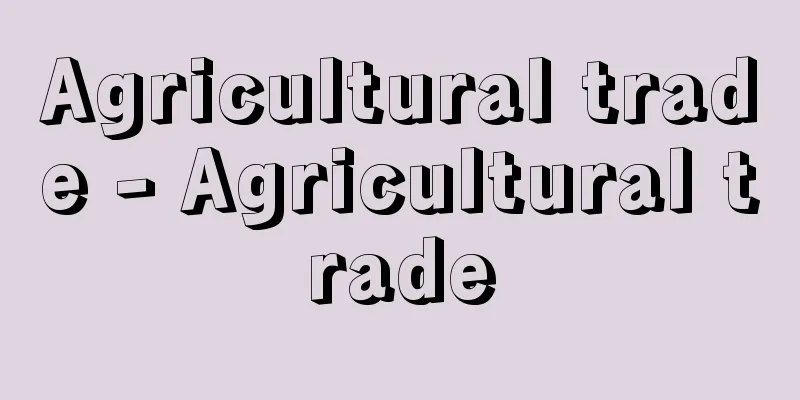Agricultural trade - Agricultural trade

|
This refers to the international buying and selling of agricultural products. The proportion of trade in agricultural products in the world is generally not that large. The proportions of grains, which account for a relatively large proportion, are 16% and beef, which accounts for 7% (average for 1981-83). The commercial nature of agricultural products means that many of them are not suitable for long-distance transportation or storage, and the food demand of a country is basically based mainly on domestic production. On the other hand, however, agricultural production is highly regional, so there are some products for which it is more advantageous to import them. As distribution technology advances and physical distribution constraints are relaxed, agricultural trade becomes an important issue from the perspective of the effective use of limited domestic resources in the process of economic development. This is the theory of international division of labor, and the theoretical basis for this is provided by the comparative production cost theory advocated in the 19th century and its descendant, the comparative advantage theory. There are two types of agricultural trade today. One is trade between agricultural and industrial countries, and the other is trade between industrial countries. Agricultural and industrial countries can be considered developing and developed countries, respectively, but trade between these countries has been stagnant since World War II. In other words, developing countries have specialized in agriculture as a result of their economic development, and have not shown any signs of increasing trade with developed countries. Rather, despite their aim to industrialize, they have not seen any results. In contrast, agricultural trade between industrial and developed countries has developed significantly. Developed countries are increasingly putting effort into industrialization, and the progress of industrialization has increased agricultural productivity, and policies to balance incomes between agriculture and industry have also contributed to the promotion of agriculture. The status of agriculture in the national economy and the weight of specific agricultural product sectors within agriculture vary from country to country, but each country exports the agricultural products in which it excels. Among the world's liberal nations, the countries with the largest agricultural imports are the former West Germany, the United States, Japan and the United Kingdom, with the ratio of agricultural exports to agricultural imports being 47%, 228%, 5% and 52%, respectively. These figures are considerable except for Japan. The countries with the largest agricultural exports are the United States, France, the Netherlands and West Germany, with the ratio of agricultural imports to agricultural exports being 44%, 78%, 65% and 213%, respectively (figures are 1981-83 averages). Therefore, when applying the theory of comparative advantage, which is the theoretical basis of the international division of labor, the following caution is necessary. That is, the division of labor should not be between agriculture and industry, but should be organized as capital-utilizing, labor-utilizing, land-utilizing, and knowledge (technology)-utilizing sectors based on the way in which production factors are combined. The question must be asked not of agriculture or industry, but of what type of sector within agriculture to specialize in. The current problems facing agricultural trade are, first of all, the stagnation of trade between developed and developing countries, which has led to the slowing of economic development in developing countries and their inability to escape poverty. This is the "North-South problem," and countries around the world must strive for a certain balance in their economic development. Secondly, there is the issue of the impact that agricultural imports have on the importing country's agriculture. It is a mistake to think that agricultural imports will lead to the general collapse of domestic agriculture, and a policy for revitalizing agriculture must be established with a positive attitude, such as by selecting agricultural products, varieties, and qualities that can demonstrate comparative advantages according to the conditions of each country and strengthening international competitiveness. Thirdly, while agricultural imports have the effect of lowering consumer prices, they can also lead to severe price instability and sometimes threaten food security. To address this, it is necessary to promote international commodity agreements, bilateral long-term agreements, diversification of importing countries, and stockpiles, as well as to maintain a certain level of domestic production and preserve the ability to switch production in emergencies. [Iichiro Takahashi] "International Division of Labor and the Japanese Economy" by Yoko Sasami (1980, Toyo Keizai Shinposha) " "Agricultural Trade and International Agreements: Searching for an Interdependent Economy" by Takahiro Saito (1979, National Institute of Agricultural and Fisheries Research) " "Imported Agricultural and Marine Products: Import Systems and Domestic Distribution" edited by Iichiro Takahashi (1982, Agriculture and Forestry Statistics Association) [Reference] |Source: Shogakukan Encyclopedia Nipponica About Encyclopedia Nipponica Information | Legend |
|
農産物の国際間での売買取引をいう。世界の農産物に占める貿易量の割合は総じてそれほど大きくない。その割合が比較的大きい穀物で16%、牛肉は7%である(1981~83年平均)。農産物の商品的性格として遠隔輸送や保存に向かないものが多いことや、一国の食糧需要の内容は基本的には国内生産物を主体とすることによる。しかし他方では、農業生産は地域性が強いから輸入したほうが有利なものもある。流通技術が進歩し、物的流通上の制約が緩和されてくると、経済発展の過程で限られた国内資源の有効利用の観点から農産物貿易が重要な問題となってくる。国際分業論がそれであって、19世紀に唱えられた比較生産費説やその系譜を引く比較優位説はその理論的根拠を提示した。 現在の農産物貿易には二つのタイプがある。一つは農業国と工業国との間の貿易であり、いま一つは工業国相互間のそれである。農業国と工業国はそれぞれ発展途上国と先進国とみてよいが、これらの国の間の貿易は第二次世界大戦後停滞的である。すなわち、発展途上国が経済発展の結果として農業に特化し、先進国との貿易が増大するという様相を示さず、むしろ工業化を目ざしているにもかかわらず、その成果があがっていないというのが実情である。これに対して工業国ないし先進国相互間の農産物貿易の発展は著しい。先進国はますます工業化に力を注いでいるが、工業化の進行は農業生産性を高め、また農工間所得均衡のための政策も農業振興に寄与した。国民経済における農業の地位や農業のなかの特定農産物部門の比重は国によって相違しているが、それぞれ得意とする農産物の輸出が行われている。 世界の自由主義国で農産物輸入額が大きな国は旧西ドイツ、アメリカ、日本およびイギリスの順であるが、農産物輸入額に対する農産物輸出額の大きさは、それぞれ47%、228%、5%および52%であった。日本を除けば相当な額に達している。また農産物輸出額が大きな国はアメリカ、フランス、オランダおよび西ドイツの順であって、農産物輸出額に対する農産物輸入額の大きさは、それぞれ44%、78%、65%および213%であった(数字は1981~83年平均)。 したがって、国際分業論の理論的根拠である比較優位説の適用に際しては次の注意が必要であろう。すなわち、農業と工業への分業でなく、生産要素の結合の仕方に基づく資本利用型、労働利用型、土地利用型および知識(技術)利用型の諸部門への分業として整理すべきである。農業か工業かではなくて、農業のなかのいかなる型の部門に特化するかが問われなければならない。 現在、農産物貿易で当面する問題としては、まず第一に、先進国と発展途上国との貿易が停滞傾向にあり、途上国の経済発展が遅れ、貧困状態から脱却できないでいることがあげられる。「南北問題」がそれであるが、世界各国が一定のバランスを保った経済発展を図らなければならない。第二に、農産物輸入が輸入国の農業に与える影響の問題がある。農産物輸入が国内農業の全般的崩壊を招くとの考えは誤りであって、その国の条件に応じた比較優位性を発揮できる農産物、品種、品質を選択し、国際競争力の強化を図るなど、前向きの姿勢で農業再生の方針を確立しなければならない。第三に、農産物輸入は消費者価格引下げの効果があるが、他方では価格不安定が激しくなり、ときには食糧安全保障も脅かされるおそれもある。これに対しては、国際商品協定、二国間長期協定、輸入先国の分散、備蓄などを進め、また一定の国内生産の維持や緊急時の生産転換能力を残すことも必要である。 [高橋伊一郎] 『佐々波楊子著『国際分業と日本経済』(1980・東洋経済新報社)』▽『斎藤高宏著『農産物貿易と国際協定――相互依存経済への模索』(1979・農業総合研究所)』▽『高橋伊一郎編『輸入農水産物――輸入制度と国内流通』(1982・農林統計協会)』 [参照項目] |出典 小学館 日本大百科全書(ニッポニカ)日本大百科全書(ニッポニカ)について 情報 | 凡例 |
>>: Agricultural production costs - agricultural production costs
Recommend
physical metallurgy
...This passion for the process of damascening pa...
Russian literature
The history of Russian literature, which spans al...
"Ihon Sankashu" - Ihon Sankashu
...According to the theory that Saigyo selected t...
Monostroma grevillei (English spelling) Monostromagrevillei
…[Mitsuo Chihara]. . . *Some of the terminology t...
Great Hummingbird - Oohachidori
…Most species are smaller than the wren, the smal...
Beauchamp, P. (English spelling) BeauchampP
…Not to mention lyrics and musical scores, dance ...
Tukārām (English spelling)
A religious poet from Maharashtra, India. An arde...
Wood fragrance - Mokkou
Herbal medicine Use for Herbal medicine One of th...
Zuiganji Temple
This is a Rinzai sect Myoshinji temple located in...
《L'homme révolté》 (English notation) Lhommerevolte
…During this time, he went to mainland France in ...
Castling
…It usually becomes the most powerful queen. (2)C...
Scaly rocks - Gansai
A dark, porous, basic volcanic ejecta. Also calle...
Overdraft - Overdraft
Overdrafts at financial institutions. Source: Abou...
Kaminokawa [town] - Kaminokawa
A town in Kawachi County in southern Tochigi Prefe...
Betsimisaraka
Tanara is a general term for the people who live ...









